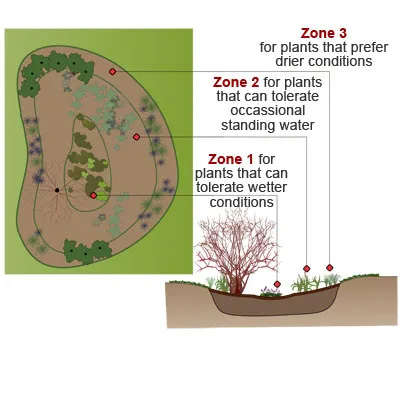Resourceful Rain Gardens

Good day to you, readers! I’m sure you’ve done all the Earth Day activities before: picked up trash, potted a plant, or enjoyed nature. Those are all great, yet, if you find yourself with that time and energy this Earth day, consider making a rain garden for more lasting aid to the planet. You’ll be carrying on a Maryland tradition since the first rain garden was started right here in Maryland by Dick Brinker of Prince George’s County. It was created as a new way to mitigate water pollution in a newly built neighborhood in Somerset.
The installation of one rain garden per house was quite effective: stormwater runoff decreased a whopping 75-80 percent as it was absorbed and filtered by the garden. Even its use at the University of Maryland, College Park, resulted in transparent water (many pollutants, bacteria, and other materials were captured and filtered successfully). Rain gardens are designated depressions or ditches where water and other sediment can drain into. You can find a completed rain garden at Heritage Farm Park (Walkersville, by the baseball fields), accompanied by a sign about its design and implementation. Rain gardens are important, successful, and downright cool! So, are you ready to learn how to make your own?
Preparation
You’re going to be digging into your yard, so call 811 to make sure you don’t hit any important sewage utilities or the like.
First, test your dirt to see if it will drain quickly enough to prevent stagnant water. Start by digging a hole six inches deep by six inches wide. You can check to see if the spot is just right by filling the hole with water and seeing if it mostly drains within 48 hours. If it does drain, begin widening the ditch. The Groundwater Foundation recommends 100-400 square feet for most homes, but you can certainly make it smaller to meet your landscaping needs
Plan to make the garden in a relatively flat area that does not have stagnant water after the rain. Try to place near areas in which pipes, drains, and driveways release excess water.
Make sure the garden is 10 feet away or more from your home’s foundation and 50 feet from a septic system.
Foundation
The deepest part of the garden should be about six inches, with the middle and outside edges forming a slight slope to make a small depression in the ground.
Use excess dirt to line the side farthest from the source of water (for you gardening nerds, you’ll be making a berm to hold leftover water that flows in).
If you’re having trouble getting water to your rain garden, dig a shallow trench from the water source to the garden. Place landscape cloth or tarp on top with stones on the sides to make a waterslide!
Planting
Select native plant varieties based on the water level they need. The trench’s deepest part must consistently tolerate wet to moist conditions, while the outer edges should tolerate dry conditions.
It is essential to use native plants for this garden. Native plants are adjusted to the water cycle and will appropriately absorb water, so there is no excess pooling.
Some good materials to line the deepest layer include: Blue Sedge, Wool Rush/Grass, Little bluestem, blue wood aster, groundsel, spicebush, growing summer sweet; middle layer: Black-eyed Susan, Alumroot, black chokeberry, hillside blueberry; outskirts: Black-eyed Susan, Butterfly milkweed, inkberry holly.
After planting, water the entire garden and add a layer of mulch. Keep watering until rain occurs. Continue to weed until after summer (and you can use your energy on harvest season instead). The only maintenance you’ll need after that is cutting down old growth.
And there you have it! A beginner’s guide to making your own rain garden. If you’re confused about any details, the Environmental Protection Agency website has several resources on how to make the garden and continue upkeep. Further, the Rain Garden Alliance has a free and easy-to-use calculator to create the dimensions for your garden.
Some other benefits of a rain garden you may experience include lovely pollinators, less flooding in your basement, and feeling like a good Samaritan.
Best of luck to you readers, and thanks for saving the Earth!
Credit to: Les Engles from The Spruce, Jeanne Huber of This Old House, James Steakly of Almanac, Viveka Neveln from Good Housekeeping, the University of Maryland Extension, The US Environmental Protection Agency, Chesapeake Stormwater Network, Davis et. al 2001 of University of Maryland Rain Garden Study, Wisconsin Department of Natural Resources, and Groundwater Foundation.

